Bo Wen
The University of Hong Kong
Universal Vessel Segmentation for Multi-Modality Retinal Images
Feb 10, 2025Abstract:We identify two major limitations in the existing studies on retinal vessel segmentation: (1) Most existing works are restricted to one modality, i.e, the Color Fundus (CF). However, multi-modality retinal images are used every day in the study of retina and retinal diseases, and the study of vessel segmentation on the other modalities is scarce; (2) Even though a small amount of works extended their experiments to limited new modalities such as the Multi-Color Scanning Laser Ophthalmoscopy (MC), these works still require finetuning a separate model for the new modality. And the finetuning will require extra training data, which is difficult to acquire. In this work, we present a foundational universal vessel segmentation model (UVSM) for multi-modality retinal images. Not only do we perform the study on a much wider range of modalities, but also we propose a universal model to segment the vessels in all these commonly-used modalities. Despite being much more versatile comparing with existing methods, our universal model still demonstrates comparable performance with the state-of-the- art finetuned methods. To the best of our knowledge, this is the first work that achieves cross-modality retinal vessel segmentation and also the first work to study retinal vessel segmentation in some novel modalities.
Enhancing Reasoning to Adapt Large Language Models for Domain-Specific Applications
Feb 05, 2025



Abstract:This paper presents SOLOMON, a novel Neuro-inspired Large Language Model (LLM) Reasoning Network architecture that enhances the adaptability of foundation models for domain-specific applications. Through a case study in semiconductor layout design, we demonstrate how SOLOMON enables swift adaptation of general-purpose LLMs to specialized tasks by leveraging Prompt Engineering and In-Context Learning techniques. Our experiments reveal the challenges LLMs face in spatial reasoning and applying domain knowledge to practical problems. Results show that SOLOMON instances significantly outperform their baseline LLM counterparts and achieve performance comparable to state-of-the-art reasoning model, o1-preview. We discuss future research directions for developing more adaptive AI systems that can continually learn, adapt, and evolve in response to new information and changing requirements.
* NeurIPS 2024 Workshop AFM (Adaptive Foundation Models: Evolving AI for Personalized and Efficient Learning)
Topology-Preserving Image Segmentation with Spatial-Aware Persistent Feature Matching
Dec 03, 2024



Abstract:Topological correctness is critical for segmentation of tubular structures. Existing topological segmentation loss functions are primarily based on the persistent homology of the image. They match the persistent features from the segmentation with the persistent features from the ground truth and minimize the difference between them. However, these methods suffer from an ambiguous matching problem since the matching only relies on the information in the topological space. In this work, we propose an effective and efficient Spatial-Aware Topological Loss Function that further leverages the information in the original spatial domain of the image to assist the matching of persistent features. Extensive experiments on images of various types of tubular structures show that the proposed method has superior performance in improving the topological accuracy of the segmentation compared with state-of-the-art methods.
FeBiM: Efficient and Compact Bayesian Inference Engine Empowered with Ferroelectric In-Memory Computing
Oct 25, 2024Abstract:In scenarios with limited training data or where explainability is crucial, conventional neural network-based machine learning models often face challenges. In contrast, Bayesian inference-based algorithms excel in providing interpretable predictions and reliable uncertainty estimation in these scenarios. While many state-of-the-art in-memory computing (IMC) architectures leverage emerging non-volatile memory (NVM) technologies to offer unparalleled computing capacity and energy efficiency for neural network workloads, their application in Bayesian inference is limited. This is because the core operations in Bayesian inference differ significantly from the multiplication-accumulation (MAC) operations common in neural networks, rendering them generally unsuitable for direct implementation in most existing IMC designs. In this paper, we propose FeBiM, an efficient and compact Bayesian inference engine powered by multi-bit ferroelectric field-effect transistor (FeFET)-based IMC. FeBiM effectively encodes the trained probabilities of a Bayesian inference model within a compact FeFET-based crossbar. It maps quantized logarithmic probabilities to discrete FeFET states. As a result, the accumulated outputs of the crossbar naturally represent the posterior probabilities, i.e., the Bayesian inference model's output given a set of observations. This approach enables efficient in-memory Bayesian inference without the need for additional calculation circuitry. As the first FeFET-based in-memory Bayesian inference engine, FeBiM achieves an impressive storage density of 26.32 Mb/mm$^{2}$ and a computing efficiency of 581.40 TOPS/W in a representative Bayesian classification task. These results demonstrate 10.7$\times$/43.4$\times$ improvement in compactness/efficiency compared to the state-of-the-art hardware implementation of Bayesian inference.
AlcLaM: Arabic Dialectal Language Model
Jul 18, 2024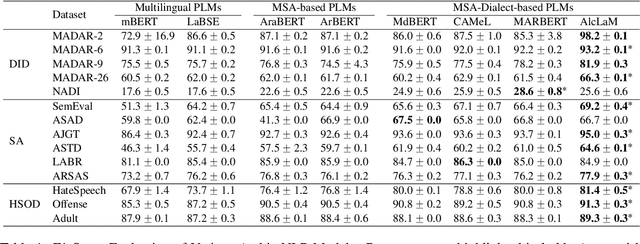
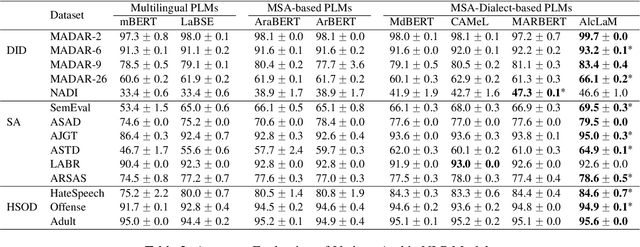
Abstract:Pre-trained Language Models (PLMs) are integral to many modern natural language processing (NLP) systems. Although multilingual models cover a wide range of languages, they often grapple with challenges like high inference costs and a lack of diverse non-English training data. Arabic-specific PLMs are trained predominantly on modern standard Arabic, which compromises their performance on regional dialects. To tackle this, we construct an Arabic dialectal corpus comprising 3.4M sentences gathered from social media platforms. We utilize this corpus to expand the vocabulary and retrain a BERT-based model from scratch. Named AlcLaM, our model was trained using only 13 GB of text, which represents a fraction of the data used by existing models such as CAMeL, MARBERT, and ArBERT, compared to 7.8%, 10.2%, and 21.3%, respectively. Remarkably, AlcLaM demonstrates superior performance on a variety of Arabic NLP tasks despite the limited training data. AlcLaM is available at GitHub https://github.com/amurtadha/Alclam and HuggingFace https://huggingface.co/rahbi.
Leveraging Large Language Models for Patient Engagement: The Power of Conversational AI in Digital Health
Jun 19, 2024



Abstract:The rapid advancements in large language models (LLMs) have opened up new opportunities for transforming patient engagement in healthcare through conversational AI. This paper presents an overview of the current landscape of LLMs in healthcare, specifically focusing on their applications in analyzing and generating conversations for improved patient engagement. We showcase the power of LLMs in handling unstructured conversational data through four case studies: (1) analyzing mental health discussions on Reddit, (2) developing a personalized chatbot for cognitive engagement in seniors, (3) summarizing medical conversation datasets, and (4) designing an AI-powered patient engagement system. These case studies demonstrate how LLMs can effectively extract insights and summarizations from unstructured dialogues and engage patients in guided, goal-oriented conversations. Leveraging LLMs for conversational analysis and generation opens new doors for many patient-centered outcomes research opportunities. However, integrating LLMs into healthcare raises important ethical considerations regarding data privacy, bias, transparency, and regulatory compliance. We discuss best practices and guidelines for the responsible development and deployment of LLMs in healthcare settings. Realizing the full potential of LLMs in digital health will require close collaboration between the AI and healthcare professionals communities to address technical challenges and ensure these powerful tools' safety, efficacy, and equity.
Turbo Sparse: Achieving LLM SOTA Performance with Minimal Activated Parameters
Jun 11, 2024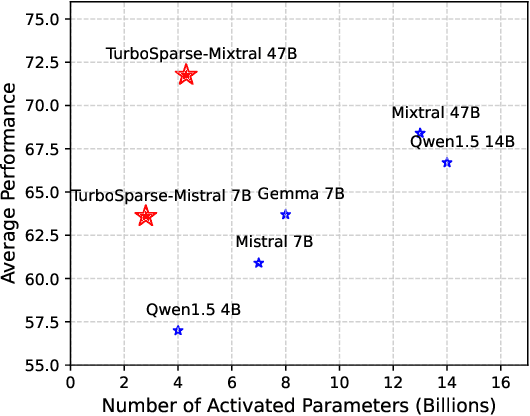
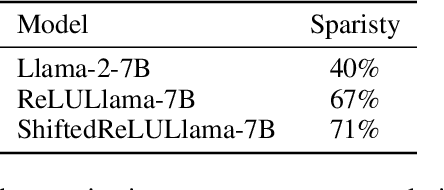


Abstract:Exploiting activation sparsity is a promising approach to significantly accelerating the inference process of large language models (LLMs) without compromising performance. However, activation sparsity is determined by activation functions, and commonly used ones like SwiGLU and GeGLU exhibit limited sparsity. Simply replacing these functions with ReLU fails to achieve sufficient sparsity. Moreover, inadequate training data can further increase the risk of performance degradation. To address these challenges, we propose a novel dReLU function, which is designed to improve LLM activation sparsity, along with a high-quality training data mixture ratio to facilitate effective sparsification. Additionally, we leverage sparse activation patterns within the Feed-Forward Network (FFN) experts of Mixture-of-Experts (MoE) models to further boost efficiency. By applying our neuron sparsification method to the Mistral and Mixtral models, only 2.5 billion and 4.3 billion parameters are activated per inference iteration, respectively, while achieving even more powerful model performance. Evaluation results demonstrate that this sparsity achieves a 2-5x decoding speedup. Remarkably, on mobile phones, our TurboSparse-Mixtral-47B achieves an inference speed of 11 tokens per second. Our models are available at \url{https://huggingface.co/PowerInfer}
Comparative Analysis of Open-Source Language Models in Summarizing Medical Text Data
May 29, 2024
Abstract:Unstructured text in medical notes and dialogues contains rich information. Recent advancements in Large Language Models (LLMs) have demonstrated superior performance in question answering and summarization tasks on unstructured text data, outperforming traditional text analysis approaches. However, there is a lack of scientific studies in the literature that methodically evaluate and report on the performance of different LLMs, specifically for domain-specific data such as medical chart notes. We propose an evaluation approach to analyze the performance of open-source LLMs such as Llama2 and Mistral for medical summarization tasks, using GPT-4 as an assessor. Our innovative approach to quantitative evaluation of LLMs can enable quality control, support the selection of effective LLMs for specific tasks, and advance knowledge discovery in digital health.
Remote Inference of Cognitive Scores in ALS Patients Using a Picture Description
Sep 13, 2023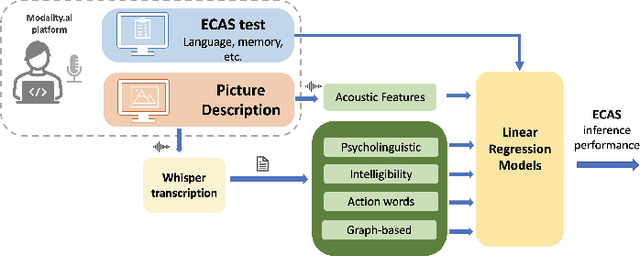
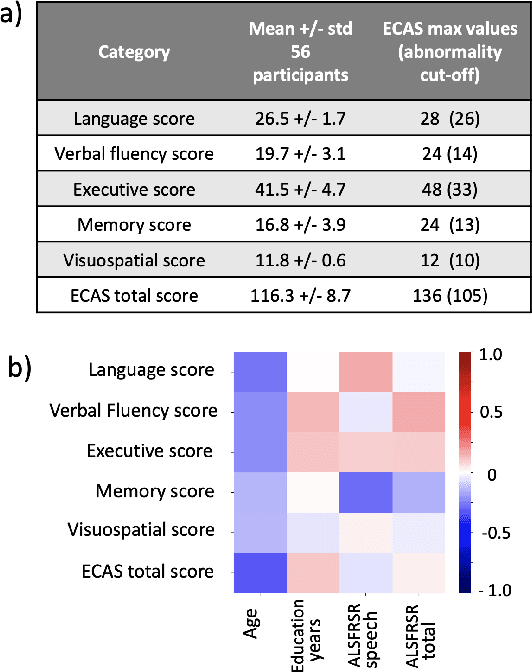
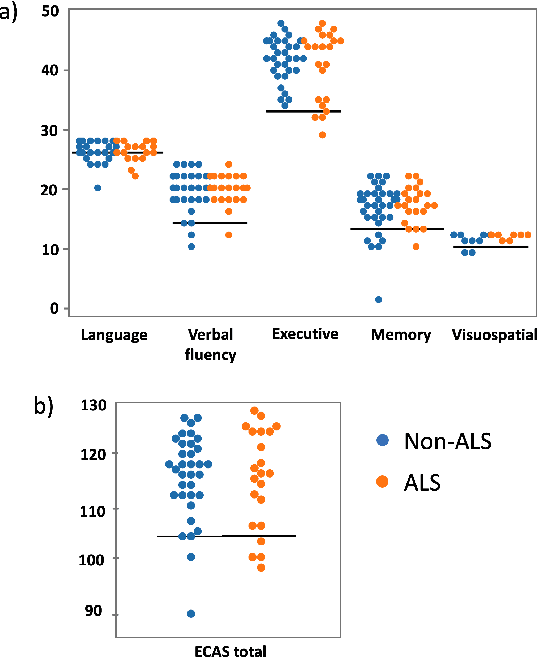
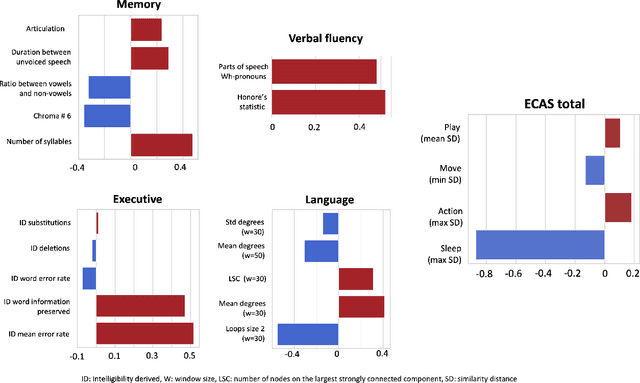
Abstract:Amyotrophic lateral sclerosis is a fatal disease that not only affects movement, speech, and breath but also cognition. Recent studies have focused on the use of language analysis techniques to detect ALS and infer scales for monitoring functional progression. In this paper, we focused on another important aspect, cognitive impairment, which affects 35-50% of the ALS population. In an effort to reach the ALS population, which frequently exhibits mobility limitations, we implemented the digital version of the Edinburgh Cognitive and Behavioral ALS Screen (ECAS) test for the first time. This test which is designed to measure cognitive impairment was remotely performed by 56 participants from the EverythingALS Speech Study. As part of the study, participants (ALS and non-ALS) were asked to describe weekly one picture from a pool of many pictures with complex scenes displayed on their computer at home. We analyze the descriptions performed within +/- 60 days from the day the ECAS test was administered and extract different types of linguistic and acoustic features. We input those features into linear regression models to infer 5 ECAS sub-scores and the total score. Speech samples from the picture description are reliable enough to predict the ECAS subs-scores, achieving statistically significant Spearman correlation values between 0.32 and 0.51 for the model's performance using 10-fold cross-validation.
Enabling the Evaluation of Driver Physiology Via Vehicle Dynamics
Sep 08, 2023

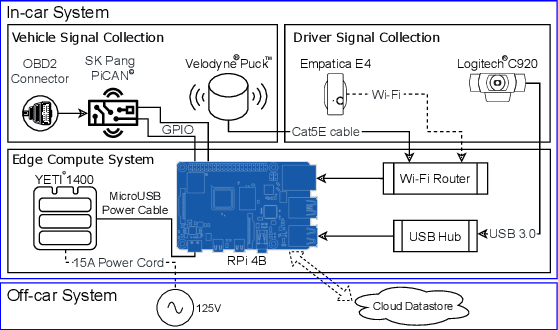
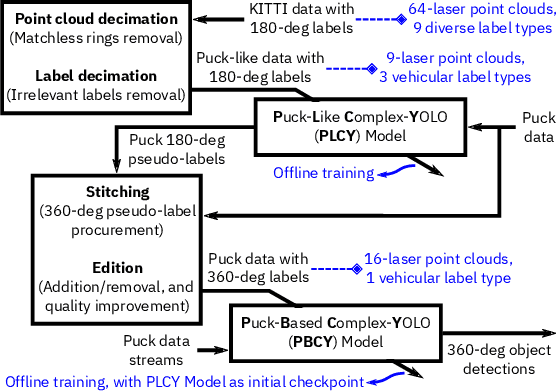
Abstract:Driving is a daily routine for many individuals across the globe. This paper presents the configuration and methodologies used to transform a vehicle into a connected ecosystem capable of assessing driver physiology. We integrated an array of commercial sensors from the automotive and digital health sectors along with driver inputs from the vehicle itself. This amalgamation of sensors allows for meticulous recording of the external conditions and driving maneuvers. These data streams are processed to extract key parameters, providing insights into driver behavior in relation to their external environment and illuminating vital physiological responses. This innovative driver evaluation system holds the potential to amplify road safety. Moreover, when paired with data from conventional health settings, it may enhance early detection of health-related complications.
* 7 pages, 11 figures, 2023 IEEE International Conference on Digital Health (ICDH)
 Add to Chrome
Add to Chrome Add to Firefox
Add to Firefox Add to Edge
Add to Edge